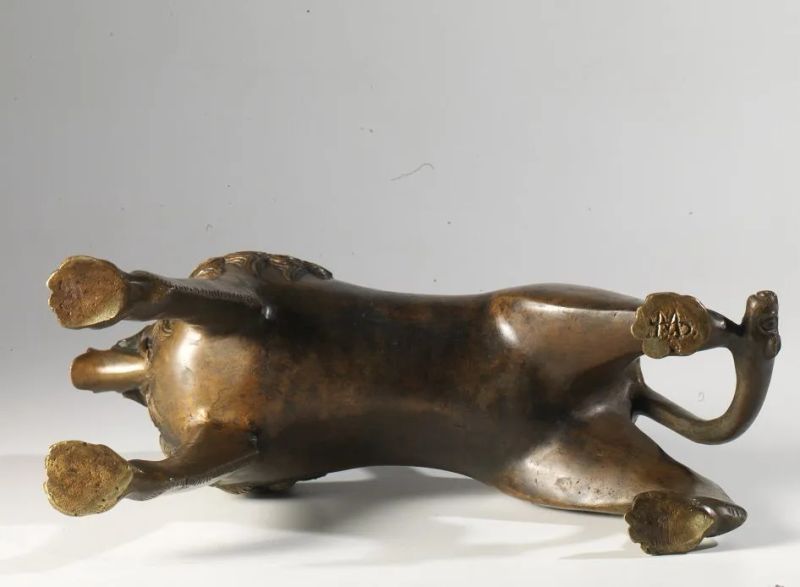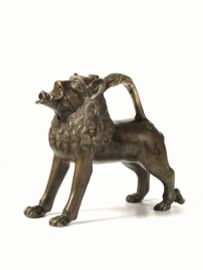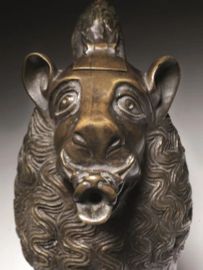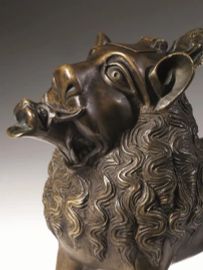BOTTEGA DI JOHANNES APENGETER, ACQUAMANILE, LUBECCA, PRIMA METÀ SECOLO XIV
in bronzo a rappresentare un leone stante, nel quale sono incorporate altre tre creature: un cane, che fuoriesce dalle fauci del leone, a formare il beccuccio, un basilisco o drago alato sul dorso del leone, a formare l’ansa, ed una testa serpentiforme nella parte finale della coda.
Cm 21,5x25,5x9,5.
Sotto la zampa posteriore sinistra è inciso il monogramma MJ, probabilmente in epoca posteriore.
WORKSHOP OF JOHANNES APENGETER, AQUAMANILE, LÜBECK, FIRST HALF OF THE 14TH CENTURY
in bronze, representing a standing lion, that incorporates three other creatures: a dog, that comes out of the lion’s jaws to form the spout, a basilisk or a winged dragon on the lion’s back to form the handle, and a serpent’s head at the end of the tail.
Cm 21,5x25,5x9,5.
The monogram MJ under the left back paw was probably engraved at a later date.
Provenienza
Collezione privata, Siena
L’acquamanile era un prezioso recipiente destinato a contenere l'acqua per lavarsi le mani, spesso foggiato a forma di animale, creatura leggendaria, cavaliere, testa o busto umano. Il termine acquamanile deriva dal latino aqua (acqua) e manus (mani) e designa un tipo di recipiente conosciuto fin dal XII secolo per permettere ai preti di lavarsi le mani durante il rito liturgico della purificazione prima dell’Eucarestia e in seguito spesso usato sulle tavole dei principi per la pulizia delle mani durante i pasti.
Realizzati con la tecnica della fusione a cera persa, gli acquamanili sono cavi e per lo più con pareti sottili: data la loro destinazione, erano provvisti di aperture per essere riempiti d'acqua e per poterla versare, nonché di un manico per la presa. La struttura di queste suppellettili è distinguibile in quattro parti, denominate corpo, impugnatura, imboccatura e versatoio.
La varietà di forme degli acquamanili è testimoniata nell’inventario del 1252 di St. Martin de Mayence, nel quale si legge al riguardo: “Erant uercei diversarum formarum quos manila vocant, eo quod aqua sacerdotum minibus funderetur ex eis, argentei, quidam habentes formam leonum, quedam draconu, avium et griphonum, vel aliorum animalorum quorumcumque”. Potevano infatti avere la forma del leone, del drago, di un volatile, di un grifo o di altri animali, come del resto possiamo riscontrare nei circa 380 acquamanili pervenuti fino ai giorni nostri, 120 dei quali presentano le sembianze del leone. Simbolo di forza e autorità, il leone fu infatti la forma più diffusa, e molti degli acquamanili realizzati in Germania furono realizzati ispirandosi al Leone di Brunswick, eretto di fronte al Castello di Dankwarderode e alla Cattedrale di Brunswick per volontà di Enrico il Leone, Duca di Sassonia e Bavaria, nel 1166 circa (vedi fig. 1).
Proprio questi versatoi sono tra i migliori esempi della produzione in bronzo medievale, i cui più importanti centri di produzione erano concentrati nelle regioni della Germania settentrionale: dalla metà del secolo XII assunse particolare importanza la città di Magdeburgo, mentre tra XIII e XIV secolo risultano note le officine della Bassa Sassonia, in particolare Hildesheim e in seguito Lubecca.
E a Lubecca fu titolare di una bottega di bronzisti dal 1332 al 1341 Johannes Apengeter (1300-1350 circa): il suo primo lavoro conosciuto, firmato, è il grande candelabro a sette braccia del Marienkirche a Kolberg (Pomerania) realizzato nel 1327, i piedi del quale, costituiti da tre leoni, presentano caratteristiche molto simili al nostro acquamanile (vedi fig. 2). Altre sue importanti opere sono il fonte battesimale della chiesa di Santa Maria a Lubecca, databile al 1337, e soprattutto il monumento funerario del vescovo Enrico Bocholt (morto nel 1341). Sappiamo dalle fonti che insieme alla produzione di opere monumentali la sua fonderia era attiva anche per oggetti di piccole dimensioni.
Proprio in quest’ambito ci sentiamo di attribuire il nostro acquamanile, basandoci anche su alcuni confronti, tra i quali quelli con un esemplare analogo (vedi fig. 3) conservato al Museo Nazionale di Copenhagen (Inv. n. 13611), uguale tra l’altro nella posa e nel modo di trattare la criniera, caratterizzata da sottili e fini motivi a forma di S profondamente incisi, e con un altro esemplare (vedi fig. 4) transitato sul mercato ad un’asta parigina (Sotheby’s, Parigi 25 novembre 2008, lotto 19) e dal 2010 conservato presso l’Art Institute di Chicago (Inv. n. 2010.30), entrambi pubblicati da Otto Von Falke ed Erich Meyer nel loro fondamentale studio del 1935 sugli acquamanili (cit. p. 185, rispettivamente nn. 444 e 445).
Bibliografia di confronto
O. Von Falke, E. Meyer, Romanische Leuchter und Gefässe, Giessgefässe der Gotik, Berlino 1935, pp. 38-96, nn. 265-611, figg. 229-558;
U. Mende, E. Cruikshank Dodd, Acquamanile, in “Treccani. Enciclopedia dell'Arte Medievale”, 1991;
P. Barnet, P. Dandridge, Lions, Dragons & other beasts, New York 2006;
D. Anedda, A. Pala, Acquamanili nella liturgia cristiana (IV-XVi secolo): il bronzo della Pinacoteca Nazionale di Cagliari, in “Anuario de estudios medievales”, n. 44/2, luglio-dicembre 2014, pp. 689-731.
The aquamanile was a precious vessel containing water for the washing of hands, often in the form of an animal, a mythical creature, a knight, or a human head or bust. The term aquamanile derives from the Latin words aqua (water) and manus (hands) and indicates a type of container known since the 12th century that priests used to wash their hands during the liturgical rite of purification before the Eucharist and that was later often used on the tables of princes for the cleansing of hands during meals.
Created with the lost-wax casting technique, aquamaniles were hollow and usually had thin walls: given their function, they had openings where they could be filled and the water could be poured from, and a handle for holding. They were composed of four parts, called body, handle, mouth and spout.
The variety of shapes of aquamaniles is related in the 1252 inventory of St. Martin de Mayence, where we read: “Erant uercei diversarum formarum quos manila vocant, eo quod aqua sacerdotum minibus funderetur ex eis, argentei, quidam habentes formam leonum, quedam draconu, avium et griphonum, vel aliorum animalorum quorumcumque”. They could in fact be found in the shape of lions, dragons, birds, griffins or other animals, as we can see from the 380 approximately aquamaniles that are still with us today, 120 of which are in the likeness of a lion. Symbol of strength and authority, the lion was indeed the most common form, and many of the aquamaniles cast in Germany were executed drawing inspiration from the Brunswick Lion, erected in front of the Dankwarderode Castle and the cathedral of Brunswick following the wishes of Henry the Lion, Duke of Saxony and Bavaria, around 1166 (see fig. 1).
These ewers are among the best examples of bronze production in the Middle Ages, of which the most important centres were situated in the northern regions of Germany: the city of Magdeburg acquired a special importance from the middle of the 12th century, while we know of laboratories in Lower Saxony, such as Hildesheim in particular and later Lubeck, between the 13th and 14th century.
In Lubeck Johannes Apengeter (1300-1350 circa) was the owner of a workshop of bronze workers from 1332 and 1341: his first known, signed work is the large candle holder with seven arms of the Marienkirche in Kolberg (Pomerania) executed in 1327, raised on three lions which very much resemble our aquamanile (see fig. 2). Other important works by the artist are the baptismal font in the Marienkirche in Lubeck, datable to 1337, and above all the funerary monument of Bishop Henry of Bocholt, who died in 1341. We know from the sources that his foundry not only produced monumental works but also objects of a smaller size.
An attribution to this sphere seems convincing, and can be confirmed by comparisons with a similar ewer (see fig. 3) in the National Museum in Copenhagen (Inv. n. 13611), which shows the same posture and the same working of the mane, characterized by thin, deeply incised S-shaped motifs, and with another aquamanile (see fig. 4) which was put up for auction in Paris (Sotheby’s, Paris, 25th November 2008, lot 19) and has been in the Art Institute of Chicago since 2010 (Inv. n. 2010.30), both published by Otto Von Falke and Erich Meyer in their basic study of aquamaniles in 1935 (cit. p. 185, respectively nos. 444 e 445).
Comparative literature
O. Von Falke, E. Meyer, Romanische Leuchter und Gefässe, Giessgefässe der Gotik, Berlin 1935, pp. 38-96, ns. 265-611, figs. 229-558;
U. Mende, E. Cruikshank Dodd, Acquamanile, in “Treccani. Enciclopedia dell'Arte Medievale”, 1991;
P. Barnet, P. Dandridge, Lions, Dragons & other beasts, New York 2006;
D. Anedda, A. Pala, Acquamanili nella liturgia cristiana (IV-XVI secolo): il bronzo della Pinacoteca Nazionale di Cagliari, in “Anuario de estudios medievales”, n. 44/2, July-December 2014, pp. 689-731.














